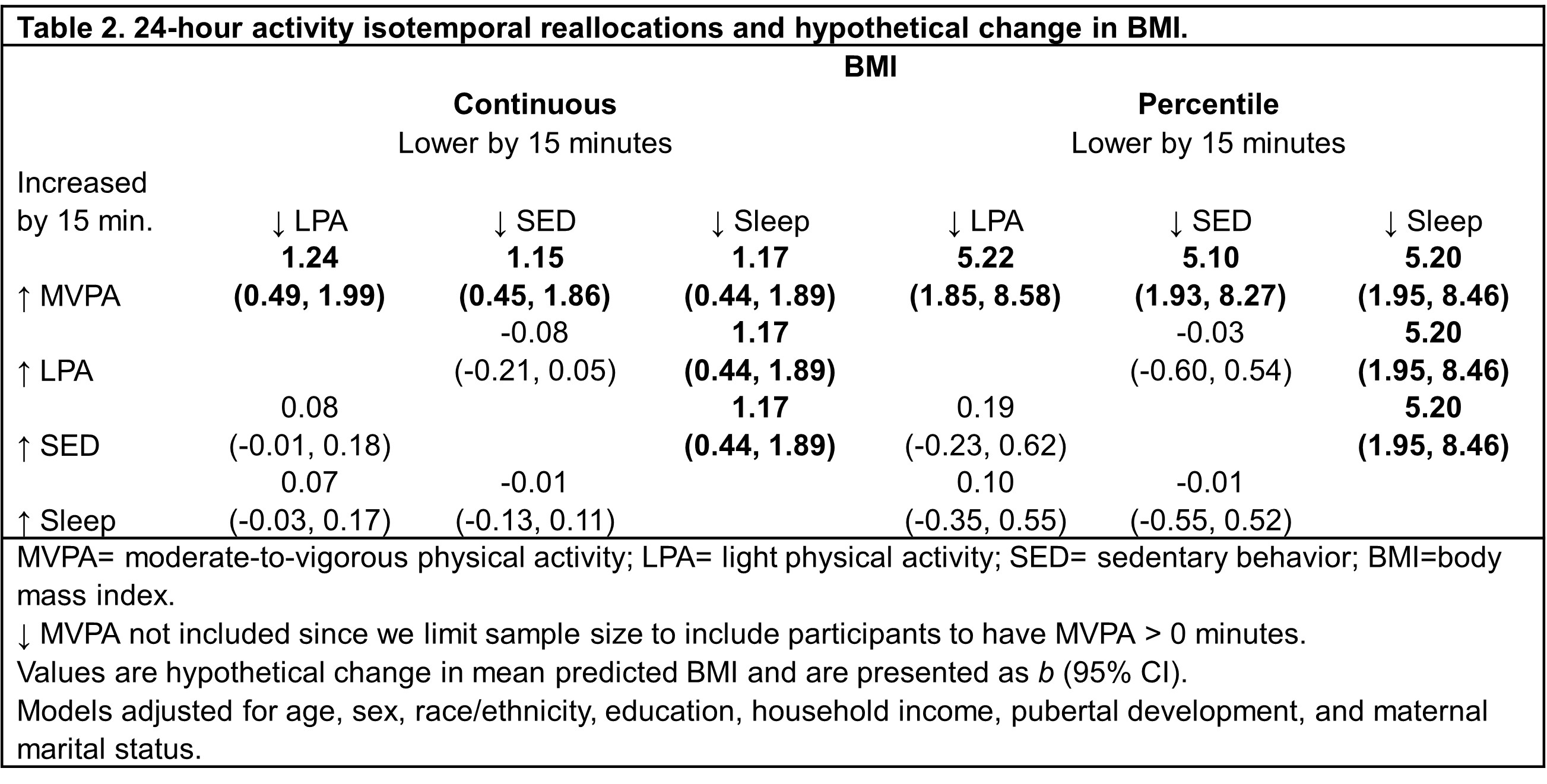Final ID: P1117
24-hour Movement Behaviors and BMI Among a National, Diverse Sample of Adolescents
Abstract Body: Introduction: Adolescence is characterized by reductions in daily physical activity and nightly sleep, which may increase the risk for worse cardiometabolic health. This study examined the associations of 24-hour movement behaviors (24h MBs), including physical activity (PA), sedentary behavior, and sleep, with BMI among adolescents in the Future of Families and Child Wellbeing Study (FFCWS).
Methods: Data included 371 adolescents (15.4±0.5 years; 46% non-Hispanic Black; 53% female) from age 15 of the FFCWS sleep sub-study. BMI was calculated using height and weight measured in-person. Wrist-worn (nighttime sleep, napping) and waist-worn (PA, sedentary behavior) accelerometers were used to assess movement behaviors over 7 days. Compositional linear regression and 15-minute isotemporal reallocations were used to examine associations of 24h MBs with BMI, adjusting for age, sex, race/ethnicity, education, household income, pubertal development, and maternal marital status.
Results: Mean BMI and BMI percentile were 24.5±6.0 kg/m2 and 70.7±27.0 percentile, respectively. Participants spent 36.8% of their day sleeping, 33.7% sedentary, 29.0% in light PA (LPA), and 0.5% in moderate-to-vigorous PA (MVPA). A greater proportion of time spent in MVPA, relative to the remaining 24h MBs, was associated with a higher BMI (b [95% CI] = 1.25 [0.5, 2.0]) and BMI percentile (5.37 [2.0, 8.8]; see Table 1). Engaging in fifteen minutes more of MVPA relative to: 1) LPA (5.22 [1.9, 8.6]), 2) sedentary behavior (5.10 [1.9, 8.3]), and 3) sleep (5.20 [2.0, 8.5]) was associated with higher BMI percentile, with similar findings for BMI. Engaging in fifteen minutes more time in LPA (5.2 [1.95, 8.46]) and sedentary behavior (5.2 [1.95, 8.46]) relative to sleep was also associated with higher BMI percentile, with similar findings for BMI (see Table 2).
Conclusions: More time spent in PA and sedentary behavior relative to sleep was associated with higher BMI among adolescents in our sample. While the PA results are paradoxical, the findings may be due to the relatively low levels of activity in this group and limitations of the BMI measurement.
Methods: Data included 371 adolescents (15.4±0.5 years; 46% non-Hispanic Black; 53% female) from age 15 of the FFCWS sleep sub-study. BMI was calculated using height and weight measured in-person. Wrist-worn (nighttime sleep, napping) and waist-worn (PA, sedentary behavior) accelerometers were used to assess movement behaviors over 7 days. Compositional linear regression and 15-minute isotemporal reallocations were used to examine associations of 24h MBs with BMI, adjusting for age, sex, race/ethnicity, education, household income, pubertal development, and maternal marital status.
Results: Mean BMI and BMI percentile were 24.5±6.0 kg/m2 and 70.7±27.0 percentile, respectively. Participants spent 36.8% of their day sleeping, 33.7% sedentary, 29.0% in light PA (LPA), and 0.5% in moderate-to-vigorous PA (MVPA). A greater proportion of time spent in MVPA, relative to the remaining 24h MBs, was associated with a higher BMI (b [95% CI] = 1.25 [0.5, 2.0]) and BMI percentile (5.37 [2.0, 8.8]; see Table 1). Engaging in fifteen minutes more of MVPA relative to: 1) LPA (5.22 [1.9, 8.6]), 2) sedentary behavior (5.10 [1.9, 8.3]), and 3) sleep (5.20 [2.0, 8.5]) was associated with higher BMI percentile, with similar findings for BMI. Engaging in fifteen minutes more time in LPA (5.2 [1.95, 8.46]) and sedentary behavior (5.2 [1.95, 8.46]) relative to sleep was also associated with higher BMI percentile, with similar findings for BMI (see Table 2).
Conclusions: More time spent in PA and sedentary behavior relative to sleep was associated with higher BMI among adolescents in our sample. While the PA results are paradoxical, the findings may be due to the relatively low levels of activity in this group and limitations of the BMI measurement.
More abstracts on this topic:
Association between accelerometer-corrected physical activity and the prevalence of hypertension, diabetes, and obesity: Results from Korea National Health and Nutrition Examination Survey, 2014-2017
Shin Woo Young, Choi Ji-yeob, Lee Hyo, Lee Miyoung
Accelerometer-Measured Sedentary Behavior and Future Cardiovascular DiseaseAjufo Ezimamaka, Kany Shinwan, Ramo Joel, Churchill Timothy, Guseh James, Aragam Krishna, Ellinor Patrick, Khurshid Shaan


